SYNOPSIS
!
SPOILER ALERT !
As
the Penguin’s birds attack the city,
a young couple seeks refuge in nearby St
Michael's Square, which the flock of
feathered aggressors seem reluctant to
enter. Relieved to be out of
harm’s way, they do however notice a
mysterious cloaked figure, almost like a
spectre, standing in front of a
monolith placed at the center of the
Square. The strange apparition approaches
the couple, strikes the woman
unconscious, and then proceeds to
strangle her boyfriend.
"There
was a feeling about him. Like an aura of
darkness."
After
paying a visit to Gotham General Hospital
and listening to the young woman’s
account of what happened, Batman and
Commissioner Gordon are left to wonder
about the bizarre circumstances of what
happened in St Michael's Square, where
the police found the victim’s body
draped across the monolith, which had
also been marked with a caduceus (the
sign symbolizing the staff of the Greek
god Hermes), painted with the
victim’s blood.
For Batman, there is
no doubt that the crime scene has a
ritualistic significance, but he has no
further leads to work with at the moment,
and so resigns himself to patrolling the
city throughout the night while Gordon
puts the GCPD on alert.
|
|
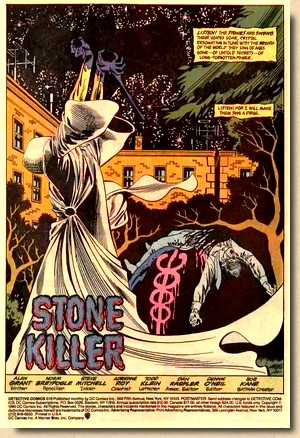 |
|
|
| |
| Meanwhile, a mugging takes
place in a rundown part of Gotham, but when the two
criminals intend to add their loot to their stash in a
dilapidated building they find themselves face to face
with an eerie and menacing figure. The almost ghostlike
apparition turns on one of the muggers, while his partner
in crime flees the building, only to run straight into
the Batman. Racing to the room in which the encounter
took place, the Darknight Detective finds no sign of the
assailant, only the dead body of the mugger - and the
same bloody symbol on one of the walls. |
| |
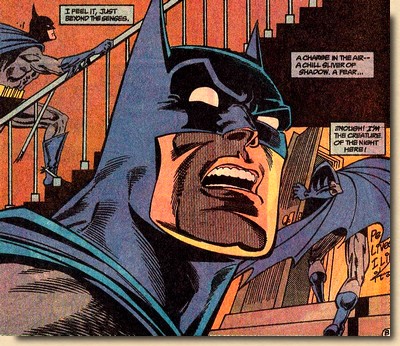 |
|
Batman
ponders the possible meaning of the
symbol left at the two crime scenes and
wonders if there might be any connection
to a nearby prehistoric site. But his
thoughts are interrupted when he
overhears a news report from an open
window regarding a recent string of
crimes perpetrated by an unknown
"red-hooded" gunman –
which gives him a horrible gut feeling
that the Joker may have survived a
previous helicopter crash and not be dead
at all. Back at the Batmobile, Batman
calls Alfred with instructions. "There’s
no mistake. Something awful was
here."
At the recently
unearthed prehistoric site he was
thinking of earlier, Batman encounters
Harv Lichas, the head archaeologist of
the excavation, who informs the Darknight
Detective that he has picked up what he
believes to be some very bad energy. At
the Batman’s request Lichas shows
him around the site and explains the
history of this so-called “serpent
mound” and its significant placement
on a "dragon line" which runs
through Gotham – in fact straight
through the two ritual murder crime
scenes.
|
|
|
| |
| Following the line, Batman
concludes the next incident might take place at
Gotham’s Veterans Hospital and speeds there in the
Batmobile, joined by Lichas. Back at Wayne Manor, Alfred follows
Bruce’s instructions as he wakes Tim, packs a
suitcase and then drives away with him. Tim tries to get
an explanation from Alfred but the faithful butler can
offer none, as Bruce simply - and urgently –
requested that they both leave Wayne manor immediately.
Upon
arrival at the Vet’s hospital Batman and Lichas
realize they are too late – a memorial statue
outside the building already has a murdered doctor
slumped on it, with the same ceremonial sign smeared on
the plaque. According to the map drawn up by lichas, the
“dragon line” now leads past the city limits
and passes very closely to Wayne Manor. Finding that
precise building empty, the mysterious hooded figure
kills a deer on the grounds of the Wayne Estate –
clearly growing stronger with every life taken.
|
| |
Knowing that Wayne
Manor is empty Batman need not concern
himself with that location and speeds by
it, hoping to catch up with the ghostly
killer as the next inhabited point on the
“dragon line” is the
archeaologist’s house. Lichas calls
ahead to his wife from the Batmobile to
warn her, but the mysterious murderer is
already at the house where he removes an
object from the solid stone mantle of the
fireplace – a rod that looks just
like the symbol drawn with the blood of
his victims.
"I
am C’th, my years span the ages.
Blood will make me strong again.
Blood… and my rod."
Arriving on
the scene, the Batman prevents the eerie
spectre from taking Mrs Lichas’s
life, catching the serial killer of
guard. However, his opponent is strong
and emits a dark aura which strikes fear
even into the heart of the Batman –
a feeling which only grows worse as the
Darknight Detective pulls back the hood
of his adversary, revealing an inhuman
reptilian sorcerer.
|
|
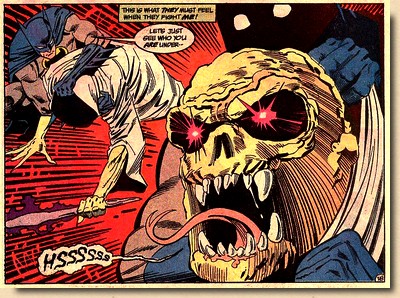 |
|
|
| |
| Punching the Batman across
the room with a blast from his rod, C’th turns to
the Lichas couple, intending to sela the rituals with a
sacrifice of both a male and female life. Sensing that
the rod is the killer’s source of power, Batman
removes his utility belt, whips it around the magic rod
and then rips it from the creature’s hand and tosses
it through the window. |
| |
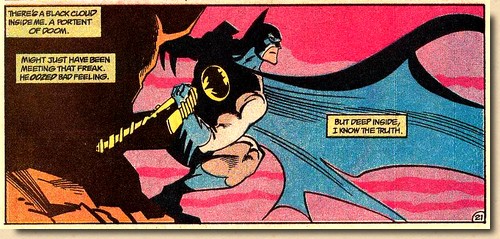 |
|
The
ancient sorcerer dives after his power
rod but can’t prevent it from being
smashed to pieces as it strikes a rocky
outcrop of the cliff – and as it
does, the malevolent C’th
turns limp and powerless and tumbles into
the ocean below, swallowed by the waves. But while this highly
mysterious and threatening ordeal may be
over, the Batman’s instincts tell
him that worse is yet to come –
knowing in his heart that the Joker is
still alive…
|
|
|
| |
| |
REVIEW & ANALYSIS
Stand-alone
and done-in-one stories were starting to become real
rarities towards the late 1980s and very early 1990s, and
in this respect Detective Comics #616 is almost
something akin to a single story transition issue,
spliced in between a three part Penguin story spilling
over from Batman into Detective Comics
for its second installment. In essence, readers are being
prepped for the return of the Joker, currently presumed
dead after a helicopter
crash in Batman #429 (January 1989), but as this was still
very much in the pre-decompression era (i.e. before trade
paperbacks dictated a six-issues target length for
stories), Detective Comics #616 actually has a
full tale to tell.
Not
everything in this storyline makes total sense, and some
plot props pop up very conveniently just when needed, but
overall the story works: there's a real villain (albeit a
somewhat supernatural one, which never really fits the
"as close to real as it gets" world of Batman
that well), there's plenty of Darknight Detective action,
and there's a pinch of philosophy thrown in. As such, it
is a rather typical Alan Grant script, given that C'th is described as a fallen
reptilian god of Ancient Babylon, crawling back to
something he believes to be his and for whom the
destruction of human life is a meaningless trifle.
|
| |

Alan Grant in the
1990s
|
|
Scotsman
Alan Grant (*1949) started out in the UK
comics industry in the late 1960s before
moving to the US in 1987 with fellow
writer/editor John Wagner to work for DC
Comics, where he would become the writer
(at first with Wagner, and then solo) of
a critically acclaimed and lengthy run on
Detective Comics and Batman
as of the late 1980s. At a point in time
when the Batman titles were becoming more
continuity heavy, Grant "unabashedly
embraced the visceral appeal of [the
Batman]" (Baytor,2017), who was
often portrayed as "furious,
insulting criminal scumbags and the
system that spawned them while burning
with indignation" (Baytor,
2017). Grant's villains were, as a rule,
dangerous and delusional and would often
seek nothing less than the destruction
and downfall of society as we know it.
In this
respect, his writing was at times hit or
miss, but it meshed extremely well with
the larger-than-life artistic style of
Norm Breyfogle.
|
|
|
| |
| Norman Keith Breyfogle
(1960 - 2018) is probably best known for precisely this
work - his pencils on Batman in Batman and Detective
Comics from
1987 to 1995. Often credited with no less than
revitalizing the Dark Knight in the 1980s, Breyfogle
discovered his passion and his talent for art at an early
age, and in 1977, aged 17, he submitted a design for
Robin's new costume (which was published in Batman
Family #13). |
| |
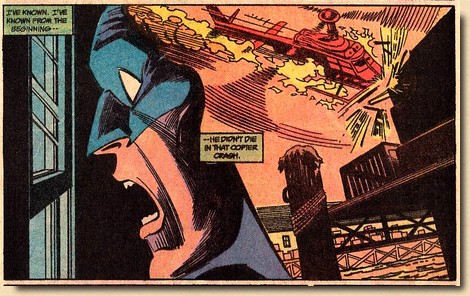 |
|
Breyfogle
attended Northern Michigan University,
studying painting and illustration, and
first got into comic books in 1984/85
when he was discovered through DC's New
Talent Showcase initiative. His rendition of
Batman was in many ways a break from the
traditional style, which up until the
mid-1980s still displayed a huge Neal
Adams influence.
|
|
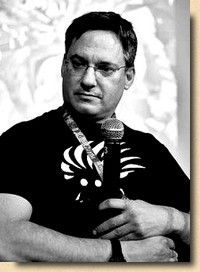
Norm Breyfogle in
2010
|
|
|
| |
| Breyfogle took the iconic
postures and designs of this Bronze Age take on Batman
but added his own and very distinct fluid designs and
dynamic storytelling techniques. At times his rendition
of the Darkknight Detective would almost take on a touch
of the famous early German impressionistic silent movies
of the 1920s, with surroundings, objects and even the
Batman taking on shapes which were utterly non-realistic.
In the hands of many it would have looked odd and cheesy,
but flowing from the pencil of Norm Breyfogle, it created
an atmosphere which was utterly compelling; as the
distortions echoed the strange forms which shadows can
sometimes take on, the stories and characters were
plunged deeply into a mysterious and sombre place - the
nightly abode of the Batman. Breyfogle's stlye was in
rather stark contrast to the ultra realistic rendition
put forward by the Tim Burton movies as of 1989, while at
the same time being a harbinger in many ways of Bruce
Timm's Batman The Animated Series (1992-1995). |
| |
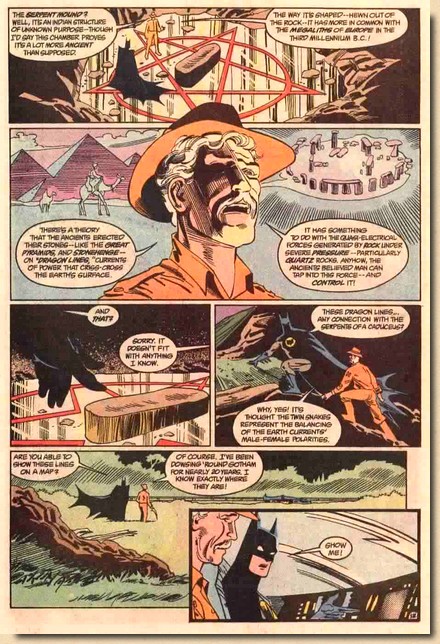 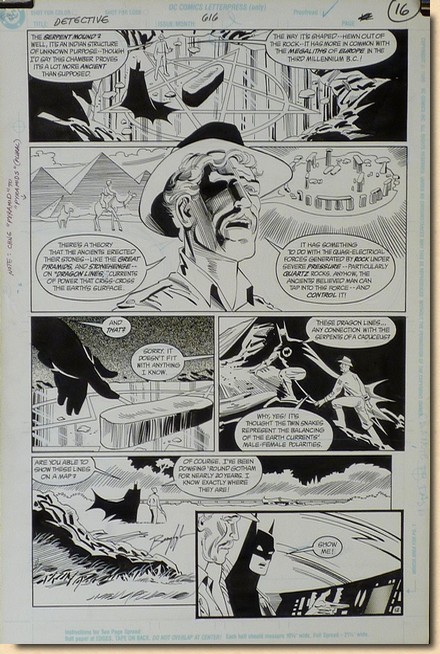
Printed page and original
artwork by Norm Breyfogle for page 12 of
Detective Comics #616, signed in panel 5 (scanned
from the original)
|
|
| |
Another trait of
Breyfogle's artwork was his rendition of dynamic
sequences of movement within the same panel, leading to
multiple renditions of e.g. the Batman within the
boundaries of what is commonly defined as a
"snapshot frame". While not his own invention
(Steve Ditko had done it here and there in early Spider-Man
issues in the 1960s, and Gene Colan experimented with
panels a lot), it became a signature element of
Breyfogle's highly unique style, which came to embody
Batman for an entire generation of readers.
"Broadly
speaking there are two different ways to approach
drawing Batman. You can choose to go ultra realistic,
and portray a man in a suit, or you can go mythic,
and portray Batman as a creature of mood and shadow.
This follows through into the writing, too. Batman
can be a pulp hero, or a troubled avenger. He can be
heroic or dark. (...) Breyfogle and Grant managed to
find a way to combine all of these things (...) into
one definitive take on the character."
(Stringer, 2014)
|
| |
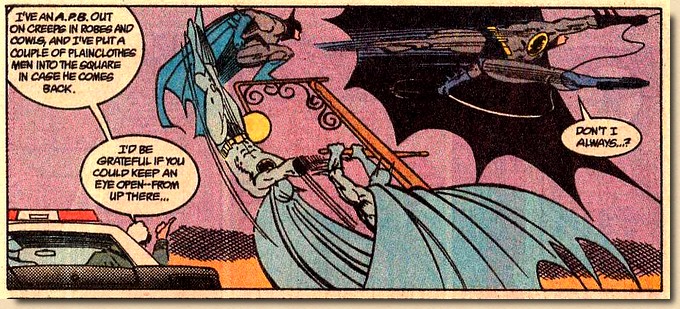 |
|
During his time on
Batman, Breyfogle co-created a number of
highly memorable villains, such as the
Ventriloquist and the Ratcatcher (with
writers Alan Grant and John Wagner).
Together
with Grant, he also created a number of
characters which still appear regularly
today, both in comics and TV shows, such
as Anarky, Jeremiah Arkham, Victor Zsasz,
and Amygdala.
|
|
|
| |
| During his six-year run on
the Batman character, Breyfogle also drew a few
one-shots, two of them being Batman: Holy Terror
(the first DC comic book to feature the Elseworlds logo)
and Batman: Birth of the Demon, which he hand
painted. Breyfogle
remained active in the comics book industry, working for
DC, Archie and independent publishers, before suffering a
stroke in December 2014 which caused paralysis on his
left body side. Given that he was left-handed, he was no
longer able to draw professionally, in spite of some
recovery. Norm Breyfogle died of heart failure on
September 24th, 2018.
His
seminal work on Batman has been reprinted in two
hardcover collected editions published by DC in 2015 (Legends
of the Dark Knight: Norm Breyfogle Vol. 1) and 2018 (Legends
of the Dark Knight: Norm Breyfogle Vol. 2). His
artwork and storytelling have stood the test of time,
they deserve to be seen and read again, and they are
truly classic material.
"Years
from now, long after we are all gone ourselves,
people will read Norm’s work, and have the same
emotion we do now to his art. Norms legacy will
continue because of the emotion he evoked. So see
Norm? No one cares what you may have learned in some
stuffy art class. They care that you knocked them out
page after page." (Kelley Jones on Norm
Breyfogle, recalling a phone conversation in which
they touched upon the technical aspects of art and
its emotional impacts, in: Jones, 2018)
|
| |
| |
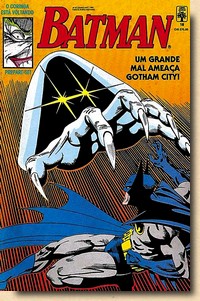
Batman #16
(May 1991)
(Editoria Abril, Brazil)
|
|
FACTS
& TRIVIA
Detective
Comics #616 went
on sale 10th May
1990 and saw multiple renditions for
markets outside the US, Canada and the
UK. The story was published:
in May 1991
by Editoria Abril from Brazil in
Batman #16 as "Assassino de
Pedra"
in September
1991 by SatellitFörlaget from
Sweden in Batman #8 as
"Sjungande Sten" (16
pages only, with original pages
2-5, 10 and 22 left out)
in September
1991 by Semic from Norway in Batman
#8 as "Steinmorderen"
(16 pages only also, identical
editing to the Swedish edition)
in 1992 by
Norbert Hethke Verlag from
Germany in Batman Sonderband
#29 as "Stein-Killer"
in February
1993 by Grupo Editorila Vid from
Mexico in Batman #134 as
"El Asesino de la Roca"
Detective
Comics #616 is collected in Legends
of the Dark Knight: Norm Breyfogle,
vol. 2 (2018).
|
|
|
| |
| As for C'th - the loss of
his power rod did not prove enough to keep him down: he
was brought back by Alan Grant himself in Demon
(Volume 3) #11 (May 1991), resurrected by Klarion the
Witchboy. His return proved to be a short one, however,
as he was once again destroyed - and has stayed that way
ever since. |
| |
| |
| BIBLIOGRAPHY BAYTER I. M. (2017)
"Alan Grant's in-yer-face Batman", in Gotham Calling,
published online 21 September 2017
JONES
Kelley (2018) "Kelley Jones Remembers and Honors
Batman Artist Norm Breyfogle", published online at Bounding
into Comics, 27 September 2018
STRINGER
Jay (2014) "My Batman: Grant and Breyfogle", BookRiot, 15 October
2014
|
| |
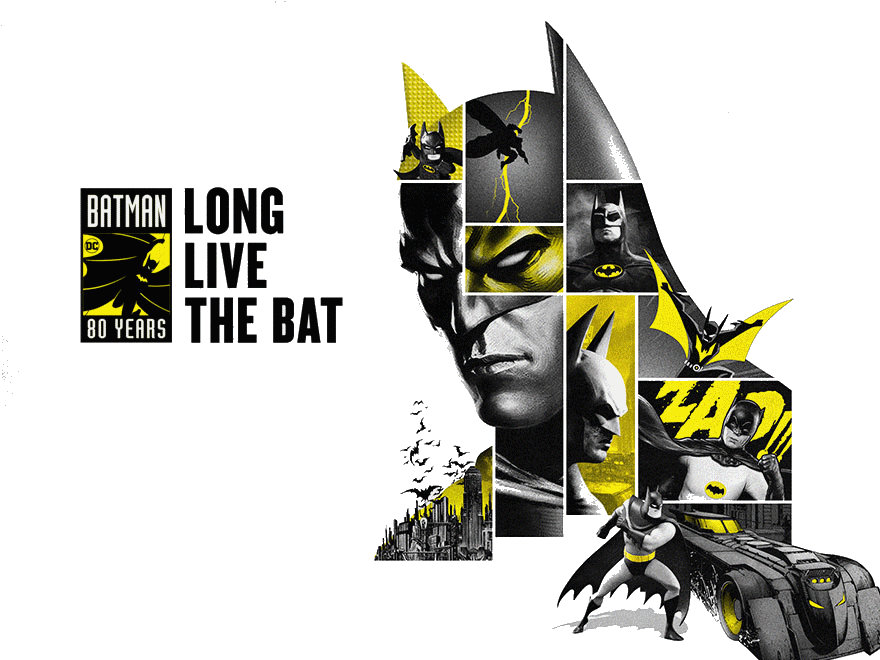
|
| |
BATMAN and all
related elements are the property of DC
Comics, Inc. TM and © DC Comics, Inc., a
subsidiary of Time Warner Inc.
The illustrations presented here are
copyright material. Their reproduction
for the review and research purposes of
this website is considered fair use
as set out by the Copyright Act of 1976,
17 U.S.C. par. 107.

(c) 2019
|
|
|
|